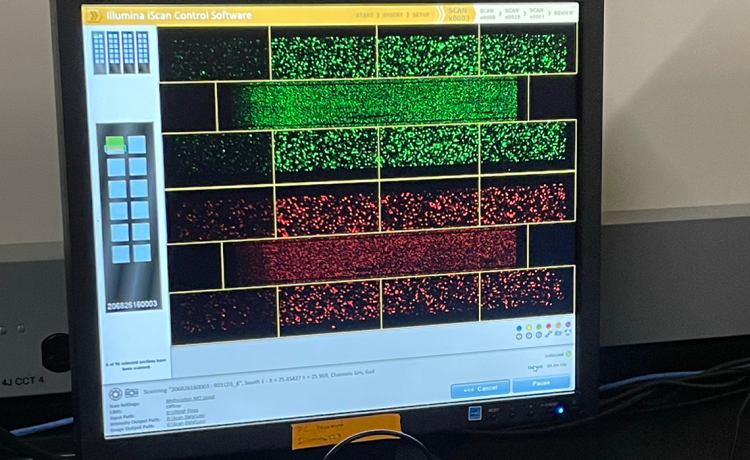One of Mount Royals's newest faculty members has brought their polar bear expertise with them to the University. Specifically, how exactly are Canada's polar bears aging?
Assistant Professor Levi Newediuk, PhD, joined the Department of Biology in 2025 after completing his postdoctoral research at the University of Manitoba. It was there that he and his colleagues embarked on a research project looking into the aging of polar bears in and around the Hudson Bay area. The study has been published online and is currently in the process of being peer reviewed.
How the project came about is a bit serendipitous, explains Newediuk.
Dr. Colin Garroway, PhD, an associate professor of biological sciences at the University of Manitoba, was Newediuk's postdoc supervisor. Garroway attended a conference on animal welfare where he heard about measuring epigenetic aging. While it piqued his interest, he knew that using the technology may not be possible. It's expensive, and hard to come by.
"There are only a few people in the world who are able to do it," Newediuk says.
Garroway returned to Winnipeg following the conference and happened to be at a gathering alongside another faculty member, Dr. Meaghan Jones, PhD. Jones is an associate professor with the University of Manitoba's Department of Biochemistry and Medical Genetics and just happened to have the equipment for measuring epigenetic aging. The project fired up, and Newediuk joined in.
Also involved was Dr. Evan Richardson, PhD, a research scientist with Environment and Climate Change Canada (ECCC). He had access to mass amounts of data on polar bears in the area, dating back to the 1980s. ECCC also provided the majority of the funding the project needed to purchase materials for the lab work. Without their dedicated work to monitoring polar bears in the area over decades the project would not have come to fruition.
Historical data used for present-day research
In humans and animals, stress can cause accelerated aging at a cellular level, known as epigenetic aging. However, Newediuk says it's difficult to measure stress in wild animals. There are lots of measures of short-term stress, such as heart rates or cortisol levels, but those only represent a brief moment in time.
"It's really difficult to get a long-term assessment of an animal's health because you would need to check things like how many times it reproduced in its lifetime, how long it's lived, and those types of things, which are really hard to measure in the wild," Newediuk explains.
Using a process called epigenetic aging, scientists are able to measure aging caused by stress over an animal's entire lifespan.
Thanks to ECCC's polar bear monitoring program, the researchers had access to not only data from the 1980s, but also dozens of hair, skin and blood samples.
"This is very useful ecology data that is otherwise rare to get."
Newediuk and the team spent a lot of time in the lab with those tissue samples, extracting them using pipettes and putting them onto glass slides dotted with segments that matched to segments in the DNA from the tissue.
Small chemical markers, known as methyl groups, attach to specific markers in the DNA. They are stained to be visible on the slides, Newediuk says, and then a computer is used to take an image.
The images, he says, look like a bunch of tiny red and green dots. The computer takes the image and reads it. That data is processed, ultimately allowing researchers to be able to measure what proportion of the entire amount of DNA that was extracted had epigenetic marks on them and which did not.

This computer image shows polar bear DNA with epigenetic marks. Courtesy of Levi Newediuk.
Those proportions change over the lifetime of an animal. Some of them are normal and expected to happen with aging. When those changes happen, that's epigenetic aging.
"Accelerated epigenetic aging just means it is happening at a faster rate," Newediuk says.
What was discovered is that epigenetic age acceleration is almost certainly happening in Manitoba's polar bear population. Changes are happening faster over a polar bear's lifetime by about two years.
"So, if the average lifetime of a polar bear in the population in our study is 30 years, for example, by the end of their lifetime they would be about (epigenetically) two years older," Newediuk explains, noting that typically polar bears don't live that long due to many other factors.
From the lab to the classroom
Teaching biology and ecology classes, Newediuk will be able to bring his research into the classroom. He hopes to highlight how important interdisciplinary research is and the significance of collaboration with colleagues.
"One thing that was surprising to me was the fact that this data set existed. ECCC has 60 years of polar bear data."
He also notes the value of ECCC's long-term research. "There's no way researchers back then would have known what the technology would be like today." He comments on how tedious it is to capture the same dataset over a ten-plus year period.
"It's the most valuable data you can have."
Newediuk and the research team hope to continue their project. Through their research they've learned that polar bears in the Manitoba region are aging, on average, two years faster. However, he says, they don't know when it matters if the bear is experiencing stress.
"These bears depend on sea ice and use it as their habitat. They also hunt seals here so they depend on a good coverage of it, but sea ice is disappearing with climate change," he explains.
Generally, sea ice levels are declining, but some years are better than others.
"What we are trying to figure out now is whether it matters if that so-called bad period of sea ice is at a sensitive period in the bear's lifetime."
Right now, an honours student at the University of Manitoba is co-ordinating data, noting what the sea ice level was when a bear was born and when it reached sexual maturity. This data will allow the team to see if there is a pattern coinciding with those sensitive periods.
They also have samples of bears and their offspring. They were taken while the bears were in gestation, but also again from later in their lifetime, allowing them to understand if those conditions in gestation and development play a role in accelerating epigenetic aging.
The samples and data used in for this project came from one population of bears around the Hudson Bay region, but there are other northern communities that share samples with research groups, allowing the research team to gather data from all across the Canadian Arctic.
"We have tissues from bears across the Arctic and their epigenetic ages. We're now looking to explore their aging related to sea ice so we will have a fuller picture of how they are aging across the arctic."
That includes bears from the most northwestern corner of Canada, the Beaufort Sea near Alaska all the way to the East Coast near Newfoundland and Labrador.
"Our faculty members come from a diverse background that represents the most cutting-edge research in biology today," says the chair of MRU's Department of Biology, Dr. Jon Mee, PhD.
"Levi's work is transferable to so many aspects of what we do in the Department of Biology, including using the best of the technology available to further society's understanding of how our environments affect the development of both plants and animals. Epigenetic aging research is an essential tool in revealing how environmental factors can influence so many aspects of how we thrive, or not, on this planet."













